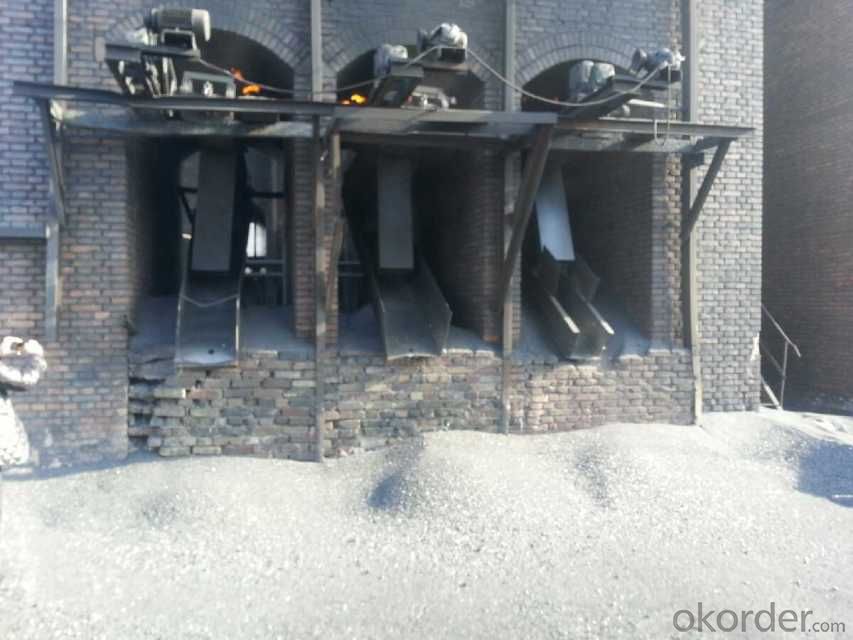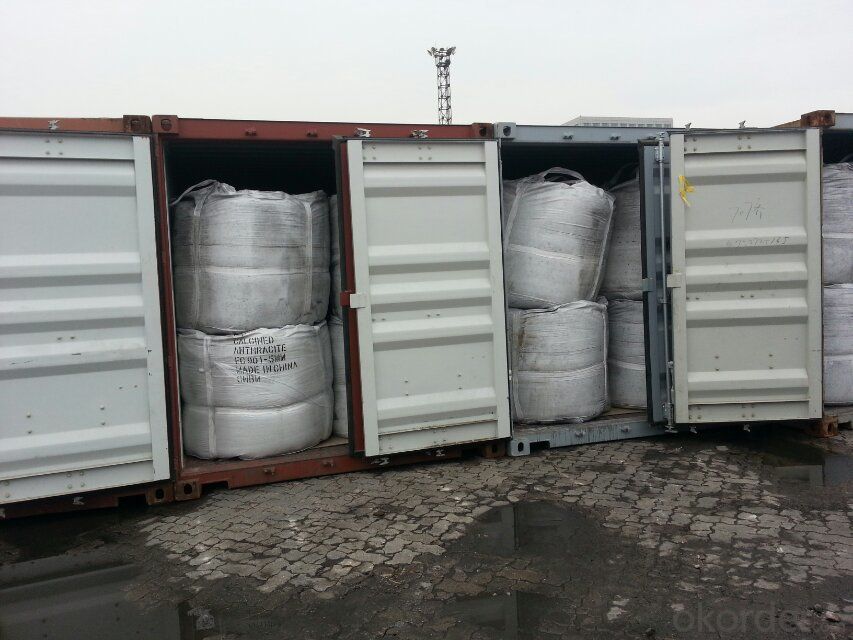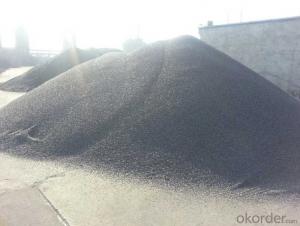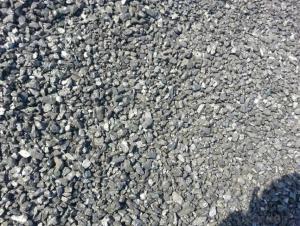Charge Coke FC90 with high and stable quality
- Loading Port:
- Tianjin
- Payment Terms:
- TT OR LC
- Min Order Qty:
- 20 m.t.
- Supply Capability:
- 3000 m.t./month
OKorder Service Pledge
OKorder Financial Service
You Might Also Like
Packaging & Delivery
25kgs/50kgs/1ton per bag or as buyer's request
Specifications
Calcined Anthracite
Fixed carbon: 90%-95%
S: 0.5% max
Size: 0-3. 3-5.3-15 or as request
It used the high quality anthracite as raw materials through high temperature calcined at over 2000 by the DC electric calciner with results in eliminating the moisture and volatile matter from anthracite efficiently, improving the density and the electric conductivity and strengthening the mechanical strength and anti-oxidation. It has good characteristics with low ash, low resistvity, low sulphur, high carbon and high density. It is the best material for high quality carbon products.
Advantage and competitive of caclined anthracite:
1. strong supply capability
2. fast transportation
3. lower and reasonable price for your reference
4.low sulphur, low ash
5.fixed carbon:95% -90%
6..sulphur:lower than 0.3%
General Specification of Calcined Anthracite:
| FC | 95 | 94 | 93 | 92 | 90 |
| ASH | 4 | 5 | 6 | 6.5 | 8.5 |
| V.M. | 1 | 1 | 1 | 1.5 | 1.5 |
| S | 0.3 | 0.3 | 0.3 | 0.35 | 0.35 |
| MOISTURE | 0.5 | 0.5 | 0.5 | 0.5 | 0.5 |
Pictures


- Q:How does carbon impact the formation of smog?
- The formation of smog is greatly influenced by carbon, specifically carbon monoxide (CO) and volatile organic compounds (VOCs). When fossil fuels are burned, like in vehicle engines or power plants, they release carbon monoxide into the air. This colorless and odorless gas can react with other pollutants under sunlight to create ground-level ozone, a major part of smog. Moreover, volatile organic compounds (VOCs), which are carbon-based compounds, are also emitted from various sources such as industrial processes, gasoline vapors, and chemical solvents. These VOCs can undergo chemical reactions with nitrogen oxides and sunlight, resulting in the formation of ground-level ozone. Both carbon monoxide and VOCs contribute to the creation of smog by reacting with nitrogen oxides (NOx) when exposed to sunlight. This reaction produces ground-level ozone, which is a primary component of smog. Ozone is detrimental to human health and the environment, and the presence of carbon emissions worsens its formation. To mitigate the formation of smog, it is crucial to reduce carbon emissions. Transitioning to cleaner and more sustainable energy sources, such as renewable energy, can help decrease the release of carbon into the atmosphere. Additionally, implementing stricter emissions standards for vehicles and industrial processes can also play a role in reducing carbon emissions and consequently limiting the formation of smog.
- Q:What are the effects of carbon emissions on the stability of estuaries?
- Estuaries, which are highly productive and diverse ecosystems, are greatly impacted by carbon emissions. These emissions, primarily in the form of carbon dioxide (CO2), contribute to climate change and ocean acidification, resulting in detrimental effects on estuaries. Sea-level rise is one of the most significant consequences of carbon emissions on estuaries. As global temperatures increase, the melting of glaciers and ice caps causes sea levels to rise. Estuaries, being low-lying areas where rivers meet the sea, are particularly vulnerable to this rise. Consequently, higher water levels lead to increased flooding, erosion, and saltwater intrusion into freshwater systems within estuaries, negatively affecting their overall stability. Furthermore, the concentration of CO2 in the atmosphere leads to ocean acidification. When CO2 dissolves in seawater, it forms carbonic acid, which lowers the water's pH. This acidification has detrimental effects on marine life within estuaries, especially organisms with calcium carbonate shells like shellfish and oysters. The increased acidity makes it more challenging for these organisms to build and maintain their shells, resulting in reduced populations and biodiversity in estuaries. Climate change, caused by carbon emissions, also alters temperature and precipitation patterns in estuaries, disrupting the delicate balance of saltwater and freshwater. Estuaries rely on this balance to support their unique ecosystems. Changes in temperature and precipitation disturb this equilibrium, causing significant shifts in species composition and distribution. Some species may struggle to adapt, while invasive species may thrive, further destabilizing estuarine ecosystems. In conclusion, the effects of carbon emissions on estuaries are extensive and varied. Rising sea levels, ocean acidification, and climate-induced changes in salinity and freshwater availability all contribute to the degradation of estuaries and the loss of biodiversity. To protect and preserve these essential ecosystems for future generations, it is crucial to reduce carbon emissions and mitigate climate change.
- Q:How does deforestation contribute to carbon emissions?
- The role of deforestation in contributing to carbon emissions is significant. When forests are cleared or burned, the carbon stored in trees and vegetation is released into the atmosphere as carbon dioxide (CO2), a greenhouse gas that contributes to global warming. Forests act as natural carbon sinks, absorbing CO2 from the atmosphere through photosynthesis. Trees and plants convert CO2 into oxygen and store the carbon in their trunks, branches, leaves, and roots. This process helps regulate the Earth's climate by reducing the concentration of CO2 in the atmosphere. However, deforestation disrupts this natural carbon storage system. The carbon once stored in trees and vegetation is released back into the atmosphere, increasing the concentration of CO2. Burning forests exacerbates this process, releasing even larger amounts of carbon through the combustion of trees and plant material. The loss of forests also leads to a decrease in biodiversity and the destruction of habitats for numerous species, which disrupts the delicate balance of ecosystems. As a result, these ecosystems become less efficient at absorbing and storing carbon, further contributing to increased carbon emissions. Moreover, deforestation indirectly contributes to carbon emissions through various means. For example, when trees are cleared, the exposed soil is exposed to sunlight and heat, causing it to dry and release stored carbon. Additionally, deforestation often leads to the conversion of land for agricultural purposes, such as livestock farming or palm oil plantations, which can increase methane emissions, another potent greenhouse gas. To summarize, deforestation contributes to carbon emissions by releasing stored carbon, disrupting the natural carbon storage system, and indirectly contributing to the release of other greenhouse gases. It is crucial to address deforestation and promote sustainable land management practices to mitigate the effects of climate change and reduce carbon emissions.
- Q:What are the different types of carbon-based food additives?
- Some examples of carbon-based food additives include caramel color, vegetable carbon (activated charcoal), and carbon black. These additives are used for various purposes such as coloring, flavor enhancement, and texture improvement in food products.
- Q:What about my world carbon board?
- What set is mod? Or pressure version... Say it clearly
- Q:How is carbon used in the production of pigments?
- Carbon is commonly used in the production of pigments due to its ability to create vibrant and deep colors. Carbon-based pigments, also known as carbon blacks, are produced by the incomplete combustion of hydrocarbons, such as natural gas or petroleum. The carbon particles produced during this process are then processed and purified to create a fine powder that can be used as a pigment. These carbon-based pigments have a wide range of applications in various industries, including inks, paints, plastics, and cosmetics. In the production of inks, carbon black is often added to improve the color intensity and opacity of the ink. It is also used in the manufacturing of black pigments for paints and coatings, providing a rich and deep black color. Carbon-based pigments are also used in the production of plastics. Adding carbon black to plastic materials can enhance their UV resistance, making them more durable and long-lasting. This is particularly important in outdoor applications where exposure to sunlight can cause fading and degradation. Additionally, carbon-based pigments are commonly used in the cosmetics industry. They are added to various cosmetic products, such as eyeliners, mascaras, and lipsticks, to create intense black or dark shades. Carbon black pigments are preferred in cosmetics due to their stability and ability to deliver consistent color. In conclusion, carbon is widely used in the production of pigments due to its ability to create vibrant and deep colors. Carbon-based pigments find applications in various industries, including inks, paints, plastics, and cosmetics, where they enhance color intensity, provide UV resistance, and deliver rich black shades.
- Q:How does carbon dioxide affect climate change?
- Carbon dioxide (CO2) is a greenhouse gas that plays a significant role in climate change. When released into the atmosphere through natural processes like volcanic eruptions or human activities such as burning fossil fuels, CO2 traps heat from the sun and prevents it from escaping back into space, leading to a phenomenon known as the greenhouse effect. The increased concentration of CO2 in the atmosphere due to human activities, primarily the burning of fossil fuels like coal, oil, and natural gas, has led to an imbalance in the natural carbon cycle. This imbalance has resulted in a rapid increase in global CO2 levels, contributing to the warming of the Earth's surface and the subsequent changes in climate patterns. Since the Industrial Revolution, the burning of fossil fuels has caused a significant rise in atmospheric CO2 levels, increasing the Earth's average temperature. This rise in temperature affects various aspects of the climate system, leading to a range of impacts. One of the most evident consequences of increased CO2 levels is the rise in global temperatures. This temperature increase leads to the melting of glaciers and polar ice, causing sea levels to rise. Rising sea levels pose a threat to coastal areas and low-lying islands, resulting in increased flooding, coastal erosion, and the potential displacement of communities. Furthermore, elevated CO2 levels contribute to more frequent and intense heatwaves, droughts, and wildfires in many regions. These extreme weather events can have detrimental effects on agriculture, water availability, and human health. Carbon dioxide also affects the balance of ecosystems by altering the growth patterns and distribution of plant and animal species. Changes in temperature and precipitation patterns, driven by increased CO2 levels, disrupt the delicate web of life, leading to the loss of biodiversity and the potential extinction of certain species. To mitigate the impacts of CO2 on climate change, reducing greenhouse gas emissions is crucial. Transitioning to renewable energy sources, improving energy efficiency, and adopting sustainable practices are some of the steps that can help reduce CO2 emissions and limit the extent of climate change. Additionally, efforts to restore and protect forests and other natural carbon sinks can help absorb and store CO2, mitigating its effects on the climate.
- Q:How does carbon affect the formation of heatwaves?
- Carbon dioxide (CO2) and other greenhouse gases trap heat in the Earth's atmosphere, leading to a phenomenon known as the greenhouse effect. Increased carbon emission from human activities, such as burning fossil fuels, contributes to the rise in atmospheric CO2 levels. This, in turn, intensifies the greenhouse effect, causing global temperatures to rise. Heatwaves are extreme weather events characterized by prolonged periods of excessively hot weather. The increased concentration of carbon in the atmosphere contributes to the overall warming of the planet, making heatwaves more frequent, intense, and longer-lasting. Hence, carbon plays a significant role in the formation and exacerbation of heatwaves.
- Q:How does carbon impact the availability of clean transportation?
- Carbon impacts the availability of clean transportation through its contribution to greenhouse gas emissions. Carbon dioxide (CO2) is a major greenhouse gas responsible for climate change, and the burning of fossil fuels in traditional transportation systems releases significant amounts of CO2 into the atmosphere. This has led to the urgent need for cleaner alternatives in the transportation sector. Clean transportation options, such as electric vehicles (EVs) and hydrogen fuel cell vehicles, are designed to minimize carbon emissions. By utilizing electricity or hydrogen as the primary source of energy, these vehicles produce zero tailpipe emissions, significantly reducing the carbon footprint associated with transportation. However, the availability and adoption of these clean transportation solutions are directly impacted by carbon-related factors. One key factor is the energy infrastructure required to support clean transportation. Electric vehicles, for example, rely on charging stations and a reliable power grid. The production of clean electricity from renewable sources, such as solar and wind, is crucial to ensure that EVs are truly emission-free. Therefore, the carbon intensity of the electricity grid plays a vital role in determining the environmental impact of electric transportation. Furthermore, the availability of carbon-neutral fuels is another important aspect. Hydrogen fuel cell vehicles, which convert hydrogen into electricity to power the vehicle, require a readily available and sustainable source of hydrogen. Currently, most hydrogen is produced from natural gas, which generates CO2 emissions during the production process. However, advancements in technologies like electrolysis, which uses renewable electricity to split water into hydrogen and oxygen, are paving the way for carbon-free hydrogen production. Additionally, carbon pricing and policies also impact the availability of clean transportation. By putting a price on carbon emissions, governments and organizations incentivize the adoption of low-carbon transportation options. This can lead to increased investment in clean transportation infrastructure, research, and development, ultimately driving the availability and affordability of clean transportation solutions. In conclusion, carbon emissions from traditional transportation systems have necessitated the development and availability of clean transportation alternatives. Factors such as the energy infrastructure, availability of carbon-neutral fuels, and supportive policies all influence the availability and accessibility of clean transportation. By addressing carbon impacts, we can accelerate the transition to a more sustainable and environmentally-friendly transportation system.
- Q:What is the concept of carbon equivalent? What is the relationship between carbon equivalent and weldability?
- There are a lot of carbon equivalent indexes such as tensile strength, yield strength of carbon equivalent, carbon equivalent, welding carbon equivalent, and crack sensitivity index (which is essentially carbon equivalent).
1. Manufacturer Overview |
|
|---|---|
| Location | |
| Year Established | |
| Annual Output Value | |
| Main Markets | |
| Company Certifications | |
2. Manufacturer Certificates |
|
|---|---|
| a) Certification Name | |
| Range | |
| Reference | |
| Validity Period | |
3. Manufacturer Capability |
|
|---|---|
| a)Trade Capacity | |
| Nearest Port | |
| Export Percentage | |
| No.of Employees in Trade Department | |
| Language Spoken: | |
| b)Factory Information | |
| Factory Size: | |
| No. of Production Lines | |
| Contract Manufacturing | |
| Product Price Range | |
Send your message to us
Charge Coke FC90 with high and stable quality
- Loading Port:
- Tianjin
- Payment Terms:
- TT OR LC
- Min Order Qty:
- 20 m.t.
- Supply Capability:
- 3000 m.t./month
OKorder Service Pledge
OKorder Financial Service
Similar products
New products
Hot products





























